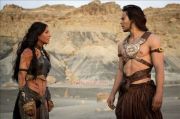Review
>
JOHN CARTER: Watch It At Home – Never Goes Into Orbit
All signs suggest that JOHN CARTER will be a financial failure of historic proportions, mostly because of its colossal cost (Disney admits to $250M, which almost certainly means close to $300M when reshoots and last-minute CG are included–and that doesn’t count the $100-150M of a big-time global marketing campaign). It would be fun to pile on and lambaste the movie as an embarrassing fiasco, or alternatively to be contrarian and point to it as an overlooked, underrated pop masterpiece, but the truth is much more tedious: it’s just a mediocre time-waster that happened to cost a ton of money.
John Carter may run short in some areas, but no one can accuse it of lacking plot. The script by director Andrew Stanton, Mark Andrews and (separately) novelist Michael Chabon is based on the novel “Princess of Mars” by Edgar Rice Burroughs, and it incorporates Burroughs himself (Daryl Sabara) into an elaborate framing device, in which he’s a young relative of Carter’s (Taylor Kitsch), summoned home after Carter’s sudden death in 1881. The story is instantly fishy–Carter’s body is in a tomb that’s been specially rigged to open only from the inside–although we have to wait for the end of the movie for it to pay off.
 Meanwhile, Burroughs reads the journal Carter left for him (cue the voice-over narration), and the main body of the story begins. Carter, a former Confederate soldier, was prospecting for gold–and had actually found a lot of it–in 1868 when he was dragooned by an evil Army officer (Bryan Cranston) into fighting Native Americans. He goes exploring in a cave where he happens to touch a magic crystal just as the mysterious, dying other inhabitant of the cave finishes saying some magic words, and instantly finds himself–
Meanwhile, Burroughs reads the journal Carter left for him (cue the voice-over narration), and the main body of the story begins. Carter, a former Confederate soldier, was prospecting for gold–and had actually found a lot of it–in 1868 when he was dragooned by an evil Army officer (Bryan Cranston) into fighting Native Americans. He goes exploring in a cave where he happens to touch a magic crystal just as the mysterious, dying other inhabitant of the cave finishes saying some magic words, and instantly finds himself–On Mars, of course, Or Barsoom, which he discovers is the natives’ name for the planet. (Earth is Jarsoom, in case you were wondering.) Where Carter, thanks to lower gravity and different bone density, can leap whole buildings in a single bound (or two at most). He finds himself embroiled in a war between 3 factions of the natives: the green 4-armed warrior Tharks (CG creations with the voices of Willem Dafoe as their leader and Samantha Morton as his daughter); the humanoid Heliums, led by King Tardos Mos (Ciaran Hinds) and his daughter, Dejah Thoris (Lynn Collins), who’s a scientist the way Denise Richards was a nuclear expert in The World Is Not Enough; and the bad-guy Zodangas, whose leader Sab Than (Dominic West) wants to destroy the Tharks and Heliums or marry Dejah, whichever comes first. Actually, the real villains are the non-Martian (I think) Therns, who are led by Matai Shang (Mark Strong), and who are meaner versions of the Watchers from Fringe who can change identity at will and feed off warfare and planetary destruction (don’t ask). Oh, and there’s a friendly giant hippopotamus/dog creature who seems to have wandered in from one of Stanton’s Pixar movies and likes to lick Carter’s face and rescue him.
 You can appreciate the ambitions of Stanton and his team–they were honestly trying to tell an epic story much classier than, say, Prince of Egypt–but the narrative is overlong, tiresome and uninvolving. The script is loaded with one howler line of dialogue after another (even after Carter has sipped a magic potion that enables him to understand and speak Martian, all the characters sound like they’re being translated from the Tharkan). Stanton doesn’t seem to want to acknowledge how silly all this is, and playing it straight just makes the movie even campier than it had to be.
You can appreciate the ambitions of Stanton and his team–they were honestly trying to tell an epic story much classier than, say, Prince of Egypt–but the narrative is overlong, tiresome and uninvolving. The script is loaded with one howler line of dialogue after another (even after Carter has sipped a magic potion that enables him to understand and speak Martian, all the characters sound like they’re being translated from the Tharkan). Stanton doesn’t seem to want to acknowledge how silly all this is, and playing it straight just makes the movie even campier than it had to be.There are fine actors in the cast, but Stanton, whose first live-action movie this is, handles them badly–the Burroughs books were an acknowledged influence on the Star Wars movies, and Stanton seems have absorbed that in the worst possible way, drawing clunky, flat line-readings from almost all his performers. (That’s not what you’re supposed to steal from George Lucas, man!) Kitsch can act, we know that from Friday Night Lights, but his low-key, naturalistic strengths don’t lend themselves at all to big-scale action-movie performing, and he and Collins couldn’t have less chemistry (Kitsch only seems comfortable acting with the 4-armed green Tharks). As the villains, Strong and West both look like they’re mentally on their respective bank websites, paying some bills.
Stanton has achieved some CG feats: the Tharks are wonderfully done, and there are Martian landscapes with genuine grandeur (of course, these are the parts of the movie most akin to the animation world from which Stanton comes). The action sequences, though, are a mess, confusingly edited and mistaking rushing for rousing.
John Carter isn’t a shameful failure; it’s just a failure. It’s Disney and not the filmmakers that has to take the blame for the size of the hole the movie going to make in the studio’s earnings.



